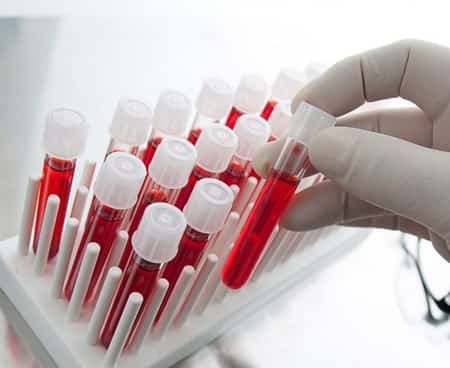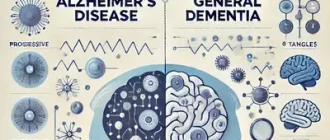Blood-based biomarkers are measurable biological indicators found in the blood that can reveal early signs of diseases, including Alzheimer’s disease (AD). These include proteins, lipids, metabolites, or genetic markers that indicate brain changes long before symptoms begin to show. Think of them as early warning signs—subtle signals your body sends out before cognitive decline becomes noticeable.
Diagnostic Accuracy of Alzheimer’s Tests by Provider Type
This chart compares the diagnostic accuracy of Alzheimer’s detection across different provider types and testing methods. PrecivityAD2, a blood-based biomarker test, significantly outperforms traditional assessments by primary care providers and specialists.
Why Early Detection of Alzheimer’s Matters
Early detection of Alzheimer’s can significantly improve treatment outcomes, quality of life, and planning for patients and families. By identifying the disease before symptoms become severe, healthcare providers can:
- Start therapies sooner
- Monitor disease progression more effectively
- Help patients participate in clinical trials
The current gold standard for diagnosis—PET scans and cerebrospinal fluid (CSF) analysis—is expensive and invasive. Blood tests, on the other hand, are faster, less intrusive, and more scalable.
The Science Behind the Markers
There are several promising biomarkers currently under research and clinical application:
| Biomarker | What It Detects | Accuracy (1–10) | Average Cost (USD) |
|---|---|---|---|
| p-Tau217 | Early tau protein changes linked to AD | 9.1 | $400 – $600 |
| Aβ 42/40 ratio | Amyloid-beta accumulation | 8.5 | $300 – $500 |
| Neurofilament light chain (NfL) | Neuronal damage | 8.0 | $250 – $450 |
| GFAP (Glial fibrillary acidic protein) | Astroglial activation | 7.8 | $200 – $400 |
These markers are typically analyzed using advanced lab techniques like immunoassays, mass spectrometry, or ultra-sensitive digital ELISA platforms.
Diagnostic Techniques: How It Works
1. Simple Blood Draw
A standard venous blood draw is performed, similar to any routine lab work like a cholesterol or vitamin D check. The process takes about 5 to 10 minutes. The patient may feel a brief pinch or sting from the needle. There’s minimal discomfort, and no fasting is required. Most individuals walk out and resume daily activities immediately.
2. Laboratory Analysis
The blood sample is shipped to a certified lab such as C2N Diagnostics or Quanterix. There, it’s processed using advanced digital immunoassay or mass spectrometry technologies. This step involves isolating and quantifying minute concentrations of key proteins like p-Tau217 or Aβ 42/40. Technicians use ultra-sensitive platforms that can detect changes invisible to standard lab methods. The analysis phase typically takes 3 to 5 days depending on lab capacity and demand.

3. Report Generation
Once analysis is complete, a report is generated indicating biomarker levels and whether they align with Alzheimer’s pathology. Results are shared with the physician electronically. The turnaround time from blood draw to report is generally 7 to 14 days. Patients are notified by their doctor and invited to discuss the findings, usually in a follow-up consultation. At this point, any unusual markers are explained in layman’s terms with clear visuals or comparative charts.
4. Follow-Up Imaging or CSF Test
If the blood biomarker profile suggests elevated risk or early signs of Alzheimer’s, physicians may recommend confirmatory diagnostics such as a PET scan or lumbar puncture. These procedures help confirm the presence of amyloid plaques or tau tangles in the brain. While more invasive and costly, they’re often used to strengthen the diagnosis before starting clinical treatment. The choice to proceed is made collaboratively, considering the patient’s health status, age, and preferences.
Predictive Accuracy of Blood-Based Dementia Risk Models
This chart displays the predictive accuracy of various blood-based dementia risk models. Combining protein biomarkers with traditional risk factors yields the highest accuracy, underscoring the value of integrative diagnostic approaches.
Real-World Cases From the U.S.
- Female, 66, Texas: Detected high p-Tau217 levels during a routine study screening. She had no prior complaints but agreed to participate in a university-led aging study. The results triggered further evaluation, revealing preclinical Alzheimer’s. She began a regimen of cognitive training, omega-3 supplementation, and enrolled in a clinical trial testing monoclonal antibody therapy. Today, three years later, her cognitive performance remains stable and she continues to live independently.
- Male, 72, California: Diagnosed based on elevated NfL and GFAP levels. He had reported frequent forgetfulness and difficulty following conversations. Blood tests revealed significant neural stress markers, prompting early pharmacological intervention with a combination of anti-amyloid drugs and lifestyle counseling. Two years into treatment, he maintains the ability to manage his finances and socialize actively, with minimal support from his family.
Benefits Over Traditional Methods
- Non-invasive: No spinal taps or radioactive tracers needed. To put it plainly, getting a blood test for Alzheimer’s is like getting your cholesterol checked. Compare that to a lumbar puncture or a PET scan, which can be uncomfortable, anxiety-inducing, and require a hospital setting.
- Affordable: Costs are significantly lower than PET or CSF testing. While PET scans often cost $3,000 to $5,000 and aren’t always covered out-of-pocket, a biomarker blood test typically runs between $300 and $600. That’s the difference between a new smartphone and a used car.
- Accessible: Blood testing can be done in rural and under-resourced areas. Not every community hospital has a PET scanner or staff trained for spinal taps. But virtually every clinic can draw blood and send it to a central lab.
- Scalable: Ideal for mass screening in clinical or research settings. Imagine screening tens of thousands of seniors in a state-wide initiative. Blood testing makes that logistically and financially possible, unlike high-cost imaging that bottlenecks due to equipment and specialist shortages.
Innovations Leading the Way
Companies like C2N Diagnostics (makers of PrecivityAD® test) and Quanterix are revolutionizing Alzheimer’s detection with ultra-sensitive platforms. PrecivityAD® has shown over 90% concordance with PET imaging, making it a game-changer.
Expert Insight
Reyus Mammadli, healthcare advisor, recommends using blood-based biomarkers for patients 60+ during annual physical exams if cognitive changes are suspected. “Early warning lets us flip the script on Alzheimer’s. The sooner we know, the more we can do.”
Editorial Advice
For patients or caregivers concerned about memory loss or cognitive decline, advocating for blood-based biomarker testing is a smart, proactive step. Don’t wait until symptoms become disruptive. The technology is available and growing in accuracy.
Effectiveness of MTBR-tau243 in Alzheimer’s Stage Detection
| Disease Stage | Detection Accuracy (%) |
|---|---|
| Preclinical | 85% |
| Early | 90% |
| Late | 88% |
This chart illustrates the effectiveness of MTBR-tau243 in detecting different stages of Alzheimer’s disease. The biomarker shows high accuracy across all stages, with peak performance in early-stage detection.
Stay informed about new developments—clinical trials are ongoing, and even more refined tests are expected to hit the market soon. And if you or a loved one qualifies for these tests, consider enrolling in a study; it could be life-changing.
References
- Janelidze, S., et al. (2020). Plasma P-tau217 in Alzheimer’s disease: relationship to other biomarkers, differential diagnosis, neuropathology, and longitudinal progression to Alzheimer’s dementia. Nature Medicine, 26, 379–386.
https://doi.org/10.1038/s41591-020-0755-1 - C2N Diagnostics. PrecivityAD® Test Overview.
https://www.c2n.com/precivityad - Quanterix Corporation. Technology and Biomarker Solutions.
https://www.quanterix.com - National Institute on Aging (NIA). What Happens to the Brain in Alzheimer’s Disease?
https://www.nia.nih.gov/health/what-happens-brain-alzheimers-disease - NPR (2024). Blood tests are poised to change how Alzheimer’s is diagnosed.
https://www.npr.org/sections/health-shots/2024/08/02/alzheimers-new-blood-tests - Alzheimer’s Association (2023). 2023 Alzheimer’s Disease Facts and Figures.
https://www.alz.org/alzheimers-dementia/facts-figures - Washington University School of Medicine. Alzheimer’s Research Publications.
https://neuro.wustl.edu - Biogen & Eisai. Aducanumab and Emerging Alzheimer’s Therapies (Press kits, FDA briefing documents).
https://investors.biogen.com
About the Author
Reyus Mammadli is the author of this health blog since 2008. With a background in medical and biotechnical devices, he has over 15 years of experience working with medical literature and expert guidelines from WHO, CDC, Mayo Clinic, and others. His goal is to present clear, accurate health information for everyday readers — not as a substitute for medical advice.







